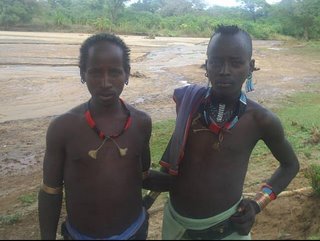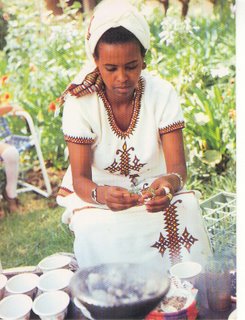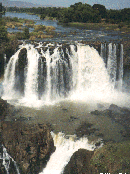communication
Saturday, December 09, 2006
Coping with a new culture and new country

Coping with a new culture and living in a new country is a big challenge for anyone. Not knowing you way around and missing your family and friends coupled with being new to everything around you are the basic challenges. Seeing new things every time and meeting a completely new people you have never met before in your life is on the other hand the fascinating thing about it.
The first thing that amazed me about the US was the highway system. As I was driving from the the airport I was so surprised at how complex the highway was. I have to admit I was a little bit scared if I would ever be able to drive on this complex road systems.
Wednesday, December 06, 2006
The Hamer People
 The Hamer people live in a very small village called Aretu which is found through “Weito” dessert in south west of
The Hamer people live in a very small village called Aretu which is found through “Weito” dessert in south west of One can be embarrassed by the sharp and amazing breast of the Hammer ladies and also absorbed by the amazing beauty male their strong muscular body (Hammers are very neat and with strong and full body in contrast to other rural areas of
Unfortunately the males don’t be involved in the routine life work all the burden of take caring the house and the kids fell on the women. The men normally take care of their body, decorations and the hair and may beget prepared and build muscles to jump the row of cutlets so as to get the bride. When you get closer to them, you will discover their hidden beauty, their Strong culture together with the charm in their face no doubt they will totally Absorbed you and immediately falls in love with them, you just want to stay and learn more about them.
Normally they don’t mind your presence; you find them doing their routine daily life. They are very kind and cooperative, invite any body new to their home .they might ask you to decorate your body with the ornamental mud that they have. Their place is known by a Nike name called mountain of love .There is high flow of tourists in that area. It is good and interesting to know about this people as a tourist, but as a citizen it is different and challenging you might ask your self what is your role on helping this people on different things like building school ,clinic and on getting clean water.
Best regards for the people of
Saturday, November 18, 2006
Injera and Wot
The most common cuisine in Ethiopia is what is called in Amharic 'Injera be wot'. Injera is a very thin flat bread made out of a grain called Teff. And wot is a spicy sauce made out of various ingredients of which doro wot is my favourite and by far the most famous one in Ethiopia. Doro wot is made of chicken and other various spicy ingredients.
Ethiopians eat their cultural food with bare hand.
The Shema - Ethiopian cultural dress

Ethiopia is an ethnically diverse country. Though I don't have formal statistics to support it I have heard that there are about 89 ethnic groups in Ethiopia. Most of these have their own language, cultural dressings, cuisines, and all the cultural things.
I will write a little bit about the main cultural dressing in Ethiopia. Thiss dressing is shared by several ethnic groups in Ethiopia including the Amharas, Tigres and the Gurages and is what people usually refer as as the Ethiopian cultural dressing.
The cloth is hand made out of cotton threads. The cotton threads are themselves usually hand made. In the cities you can go and buy these clothes from the shops. But in the rural areas it is very common that the ladies make the threads and give them to the traditional weavers called the 'shemanes' who in turn weave and make the cloth out of it.
Clothes made in these ways are called shemas in Ethiopia. The shemanes's put different designs and embroideries on the shema which makes it colorful and very attractive. In the rural areas most of ladies clothes are still made of the shema. Thick shawls made of shema are also worn by men in the rural areas specially during the cold seasons.
The picture above shows an Ethiopian girl wearing a decorated shema cloth preparing coffee.
Sunday, November 05, 2006
Thirteen Months of Sunshine

If you happen to visit Ethiopia you will notice some posters which refer to the country as thirteen months of sunshine . This comes from the fact that you can see the sun in every month of the year in Ethiopia. Believe me but in much of the country there is even no need of air conditioning for much of the year. I will have a future blog on Ethiopian weather but for today I will say a little bit about the Ethiopian Calandar
You might be wondering why I said 13 months and not 12. Ethiopia has it's own calender called the Ethiopian calender which has 13 months rather than 12. All the 12 months have 30 days and the 13th (called Pagumen) has 5 days except in leap year when it will be 6. The Ethiopian calendar is based on the old Alexandrian calendar though I wouldn't go into the details for a novice there are two obvious differences:
- It is 02/26/1998 in Ethiopia on Nov 5, 2006 in Gregorian Calendar
- Every fourth year is a leap year in Ethiopian calender without exception.
The picture above is the famous Tis Isat falls of the blue nile river found in Bahir Dar Ethiopia
about myself

My name is Etsegenet Simachew and I am an MBA student at the University of Northern Virginia .
I am an Ethiopian and I will be posting about Ethiopian culture in the coming few blogs. Please keep checking my blog as I will be posting many things about Ethiopia - referred to as the land of 13 months of sunshine.
This is a picture of me taken at the Missouri Botanical garden in St. Louis. - a must visit if you happen to visit st Louis. I promise to post a picture of me in Ethiopia in a future blog.

